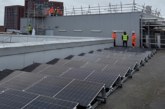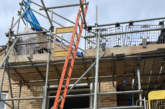 Following the global focus on sustainability prompted by COP26, 300 public and private sector industry professionals recently came together to learn about how the built environment can do more and go further in their efforts towards net zero. Ed Reynolds, Midlands Technical Director at Willmott Dixon, reflects on the recent ‘Net Zero – What’s Stopping Us?’ panel event hosted in Birmingham and how the spirit of collaboration was felt more than ever.
Following the global focus on sustainability prompted by COP26, 300 public and private sector industry professionals recently came together to learn about how the built environment can do more and go further in their efforts towards net zero. Ed Reynolds, Midlands Technical Director at Willmott Dixon, reflects on the recent ‘Net Zero – What’s Stopping Us?’ panel event hosted in Birmingham and how the spirit of collaboration was felt more than ever.
Collaboration and transparency. If there were two words I heard over and over again during our debate, it was those.
It felt like times of old once again, with colleagues, customers and fellow industry professionals all gathered together with a shared interest to discuss. Events such as this offer a timely reminder of what can be achieved when we take the time to catch up with one another properly, instead of via Zoom or Teams, which we have all become reliant on over the past two years.
Bringing everyone together to discuss such a hot topic post-COP26 meant we saw over 300 people and from various organisations and walks of life – local councils, designers and consultants, students, universities, tech companies, LEPs and more. It was heartening to see the sector united in their efforts to drive forward sustainable practices and push for industry action in tackling the climate emergency.
It was my pleasure to open the event on behalf of Willmott Dixon and introduce our knowledgeable and insightful panellists, including our very own Julia Barrett; Deborah Cadman OBE, Chief Executive of Birmingham City Council; Belinda Morgan from Cundall; Tim Carey, Chief Product Director at Collida; James Douglas from Lendlease, and Chris Clarke from Scape.
Together, the expert panellists pointed out opportunities for growth and shared visions for the future, whilst sparking meaningful conversations and drawing on their breadth of cross-sector experience.
Our sustainability strategy Now or Never, sets out our key priorities in three parts to take us to 2030: Brilliant Buildings, Building Lives and Better Planet. As a business we know that all three are important to align our customers, supply chain and the wider community in meaningful ways. But we also know that each of these three areas take investment, a commitment to continuous learning and development, and a determination to engage, collaborate and innovate to drive sustainability above all other interests.
Judging from the atmosphere in the room, and the conversations that have followed, the event has already had a significant impact, and I look forward to working closely with our industry on the topic again.”
Challenging behaviours
One of the underpinning themes throughout the debate was the pace at which we need to change attitudes towards sustainability in the sector. To prevent the ‘race to the bottom’ on price, contract selection must be geared more towards sustainability.
Deborah gave her views, insisting that Birmingham Council would “turn investment and development away if it’s not done with good intent and with low carbon in mind.”
James, representing Lendlease, agreed: “We must report our performance and share our progress. I don’t want to see carbon become commercial, we’re all on the same journey. We are going to turn down investment and development opportunities if they don’t have low carbon in mind. We will simply say this is not the place for you.”
Julia also challenged panellists on the performance gap – or, in her words, “how long are we going to be building buildings that don’t do what they say on the tin?”
To ensure effective designs are robustly delivered on-site, it was agreed that more needs to be done in terms of legislation and holding businesses to account over sustainable standards – though believed the ‘carrot over the stick’ approach would be more effective to set targets and encourage greater collaboration. This is something I wholeheartedly believe in myself.
Belinda, speaking on behalf of engineering consultancy Cundall, emphasised that “early engagement is the key to collaboration” – and provided an example of where they had been appointed on a contract following a behavioural workshop to determine the team’s efficiency and said that fees came secondary. Belinda said the scheme was highly successful and believed that lessons could be applied from the experience. Cundall became carbon neutral last year.”
We’re not moving quickly enough
There were also discussions about how many retrofits to buildings is now required, all of which could have been avoided had available energy-efficient methods been implemented at the time of construction.
To echo this, Deborah said that it is “almost criminal” for gas boilers to be installed in new homes in the next five years. Deborah was also “not convinced that innovation, research and development is where it needs to be. The industry needs to work with higher education institutions to fix this.’
A section of the discussion focused on ‘whole life value’, and Julia explained how “we’re going to see the decarbonisation of the grid by 2035, which is when we will see embodied carbon take over.”
James believes that “it’s the biggest challenge to the construction sector. There is no legislation in place to drive forward lower embodied carbon and very little reporting. Leading private sector organisations are tackling this independently, but I believe there needs to be policy and intervention.”
Whilst positive strides from government have been made in recent years, I think that the allocation of funding to meet sustainability targets has been a cause of concern.
Julia pointed out that that the Code for Sustainable Homes existed in 2006 but was scrapped in 2016. She said that if the UK had stuck with it, every house being built today would be net zero carbon – and reiterated messages from her recent webinar series, shared as a podcast here.
Tim explained that Collida was established because they knew the construction industry needed to change. He said: “We know that we need to accelerate our rate of modernisation, embrace aspects such as the Construction Playbook and offsite manufacturing. We want to operate with integrity, so we chose to use the Passivhaus standard to deliver our net zero carbon aspirations. The solutions all exist. We’ve gone on a journey to learn about net zero carbon, but fundamentally we haven’t invented a radical new material that didn’t exist before. We have just found the right solutions and are now trying to employ them at scale because that’s what’s needed.”
Comments that we have ‘shot ourselves in the foot’ or fell flat on attempts to ‘reinvent the wheel’ demonstrated that patience is wearing thin as we look to the government to implement measures to support lasting change.
COP26 – the verdict?
Our panel, whilst offering a balanced view of the COP26 summit and Glasgow Climate Pact, largely felt it didn’t go far enough.
Deborah said: “How much more evidence does the world need that we need to act now. How many more natural disasters will it take before people understand the position we are in? The power of youth is inspiring; however, they are not the ones making the decisions, which is concerning.”
James also started the conversation on sustainable materials, explaining that “COP26 happened and 40 countries signed up to a new carbon zero steel commitment. Which countries was it? Nobody knows because nobody even published that fact. People need to be talking about this and we as an industry need to create the demand for this solution.”
This kickstarted a debate about the procurement of steel, timber and concrete and the importance of leading with demand and educating the supply chain, insurers, and developers.
Chris said there were two things we should be worried about: steel and concrete. He said: “If we don’t change our standards, the steel firms will not change. If we do change our standards now, we give the UK steel industry a fighting challenge of producing net-zero steel when everyone will be demanding it.”
These are just some of the highlights from the session, which covered a lot of ground in just a few hours. These conversations will continue outside of the event, and we look forward to using the event as a springboard for progress and ongoing collaboration.”
The full version of this event is available via podcast here or on YouTube here.









